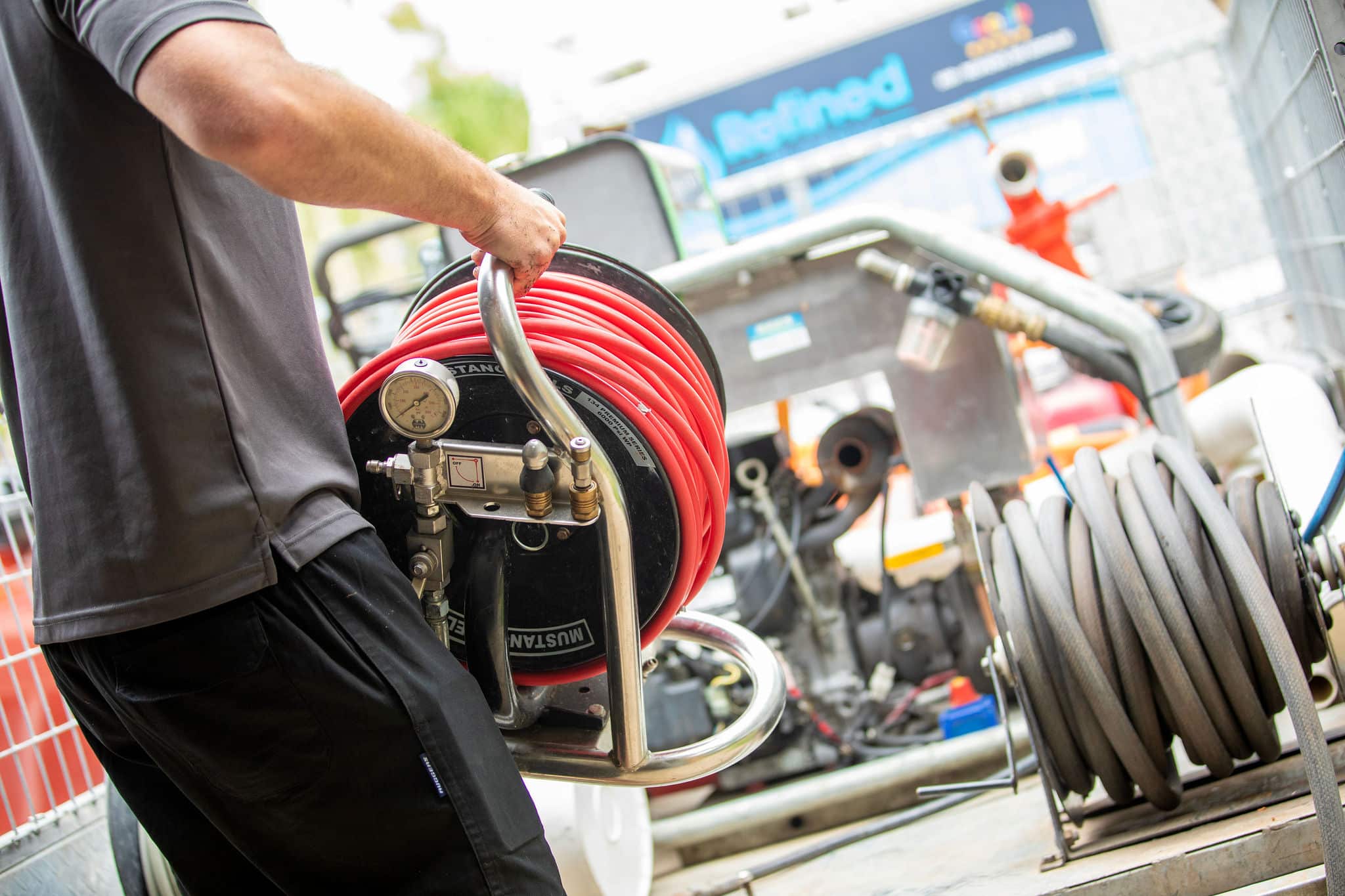TL;DR – What to check when water flow is low in your home
- Low water pressure can be caused by leaks, corroded pipes, mineral buildup, or faulty pressure valves.
- Start by cleaning your taps and shower heads, checking your water meter, and inspecting visible plumbing.
- If you’re experiencing low water pressure in house taps or persistent low water pressure in shower fittings, it’s time to call a licensed plumber to fix water pressure in your home.
- Ongoing maintenance, including hot water servicing and annual valve checks, helps prevent pressure problems in future.
Introduction: Why is your water flow suddenly low?
When your tap turns into a slow dribble or your shower goes from refreshing to frustrating, chances are you’re experiencing low water pressure. It’s a common issue on the Sunshine Coast, where a mix of older homes, changing water conditions, and subtropical weather can all contribute to plumbing wear and tear.
Low water pressure in house systems can affect everything from how quickly you can do the dishes to how well your washing machine runs. If left unchecked, it can also signal deeper issues in your plumbing – including water leaks, outdated fixtures, or failing pressure regulators.
Even newer homes aren’t immune. From construction sediment in pipes to partially shut-off valves after planned works, pressure drops can come from a surprising range of causes. Acting sooner not only improves your water flow – it can also help you avoid bigger, more expensive problems later on.
Common causes of low water pressure in the home
Mineral deposits clogging your taps and shower heads
A drop in pressure from specific taps or a low water pressure in the shower fitting is often due to mineral buildup inside your tapware. As hard water flows through your home, it leaves behind calcium and magnesium deposits that gradually clog aerators and shower nozzles.
This can cause:
- Uneven or weak water flow
- Whistling noises from the tap
- A spray that sprays in all directions – or none at all
Regular cleaning is key to avoiding buildup, and in areas with high mineral content, a whole-home water filter may be a smart upgrade.
DIY cleaning tip:
- Unscrew the tap aerator or showerhead.
- Soak it in white vinegar for 4–6 hours.
- Scrub gently with a toothbrush.
- Rinse thoroughly and reinstall.
This alone can resolve low water pressure from specific outlets.
Leaking water pipes and joints in your plumbing system
Leaks don’t always show up as puddles. Hidden leaks behind walls or underground can lead to significant low water pressure in house zones.
Clues to look for:
- A sudden increase in your water bill
- Damp or mouldy patches on walls or flooring
- A constantly running water meter, even when no water is being used
Even a pinhole leak can affect flow to an entire section of your home. If the leak is on the hot water side, it can also cause low water pressure in shower fittings that rely on balanced hot/cold flow.
Your licensed plumber can pressure-test your lines and use tools like thermal cameras or acoustic listening devices to find leaks without digging.
A partially closed or faulty pressure-reducing valve (PRV)
Your PRV helps control the amount of water pressure entering your home from the main water supply. If it’s not fully open or is partially blocked, it may restrict flow throughout the home – especially at peak usage times like early mornings or evenings.
In some homes, this valve may be misadjusted or never fully opened after maintenance. It’s a common oversight that causes low water pressure, even in new builds.
Never attempt to adjust your PRV on your own – these valves are under pressure and must be serviced by a qualified plumber. If yours is old, damaged or incorrectly sized, it may need to be replaced entirely.
Pressure regulator problems reducing water pressure
Similar to a PRV, the pressure regulator ensures your home isn’t getting too much or too little water flow. If it fails, you might experience:
- Fluctuating pressure throughout the day
- Noisy pipes or “hammering” sounds
- A significant drop in flow, even when only one tap is on
This often results in widespread low flow pressure in house areas. If you’ve ruled out blockages and cleaned fixtures with no improvement, the regulator could be to blame.
A plumber can test the pressure at your meter reading and at key outlets around the home to confirm whether a replacement is needed.
Corroded or aged water pipes restricting flow
Old metal pipes, especially galvanised steel or untreated copper, can corrode internally. Over time, rust and sediment buildup narrows the diameter of the pipe and reduces flow – especially to upstairs bathrooms and shower fittings.
Pipe corrosion doesn’t just affect pressure – it can also impact water colour and taste. If your water looks cloudy or metallic and pressure is low throughout the home, it might be time to re-pipe sections of your plumbing.
How to fix low water pressure yourself (safely)
Clean aerators and shower heads to remove buildup
If your shower or tap is running weak, try removing the aerator or head and soaking it in vinegar overnight. Scrub gently, rinse, and reattach.
This simple trick can often resolve low water pressure in shower heads or bathroom sinks without any tools.
Check your hot water system for pressure issues
Hot water can be a separate issue. If you only notice low water pressure in the shower or taps when using hot water, the problem may be:
- A blocked filter or line
- Sediment buildup in your hot water tank
- A failing tempering valve
An annual hot water service can keep your system running smoothly and pressure balanced across all outlets.
Test the water pressure at different outlets
Check all your taps and outdoor spigots:
- If only one tap is affected, it’s likely a local issue
- If low water pressure is everywhere, it could be a valve, regulator, or supply issue
- Outdoor taps can be useful for isolating supply-related problems
This process can help you identify and narrow down the root cause – and provide helpful info when calling your plumber.
Inspect for visible leaks or damage
Check under sinks, near hot water systems, around your meter box, and external connections. Even small, slow leaks can cause widespread low water pressure in house plumbing – and cost you money in the long run.
Make sure the main water valve is fully open
Sometimes, the issue is as simple as a valve not being turned all the way. During renovations, planned works, or property inspections, valves may be partially closed and forgotten.
To check:
- Find your main shut-off valve (usually near your water meter).
- Turn it counterclockwise until it stops.
- Recheck pressure at multiple taps.
When to call a licensed plumber for low water pressure issues
You’ve done the checks – but the pressure’s still low? It’s time to call in the professionals if:
- You’ve got low water pressure in house outlets that don’t improve
- Your hot water flow is affected
- You suspect a hidden leak, internal blockage or failing regulator
- Your system has older pipes prone to corrosion
- You’ve had low water pressure in shower areas for a while, with no clear cause
Expert plumber insight: Why it pays to act early
“We’ve seen Sunshine Coast homes suffer from years of low water pressure without knowing the real cause. A quick inspection by a licensed plumber can save you time, money, and frustration down the track.”
– Izaak Stains, Owner, Refined Plumbing Sunshine Coast
How a licensed plumber can fix low water pressure permanently
Your plumber can:
- Measure pressure at key points across your plumbing system
- Diagnose leaks or internal restrictions using cameras and gauges
- Service or replace faulty valves, regulators or filters
- Re-pipe damaged sections of the line or old, corroded pipes
- Recommend booster systems for larger properties or dual-storey homes
These services restore proper water flow and ensure your plumbing performs efficiently long-term.
Preventing low-pressure problems in the future
- Clean showerheads and aerators every few months
- Service your hot water system annually
- Monitor your water meter for unexpected movement
- Avoid DIY tampering with valves or regulators
- Replace ageing pipes during renovations or kitchen/bathroom upgrades
Final thoughts: Don’t let low water pressure go unchecked
Low water pressure can be a frustrating issue – but it’s often the symptom of a deeper problem. Whether it’s a leak, valve, regulator, or ageing pipes, acting early can save you hassle down the line.
If you’ve cleaned your taps, checked your water meter, and still have low water pressure in shower heads or kitchen outlets – it’s time to get it sorted properly.
Contact Refined Plumbing Sunshine Coast
Need help restoring your home’s water pressure? Refined Plumbing offers expert diagnostics and long-term solutions for low water pressure in the house and hot water systems.
Request a quote online or call 0405 142 154 – and get your water flowing freely again.



